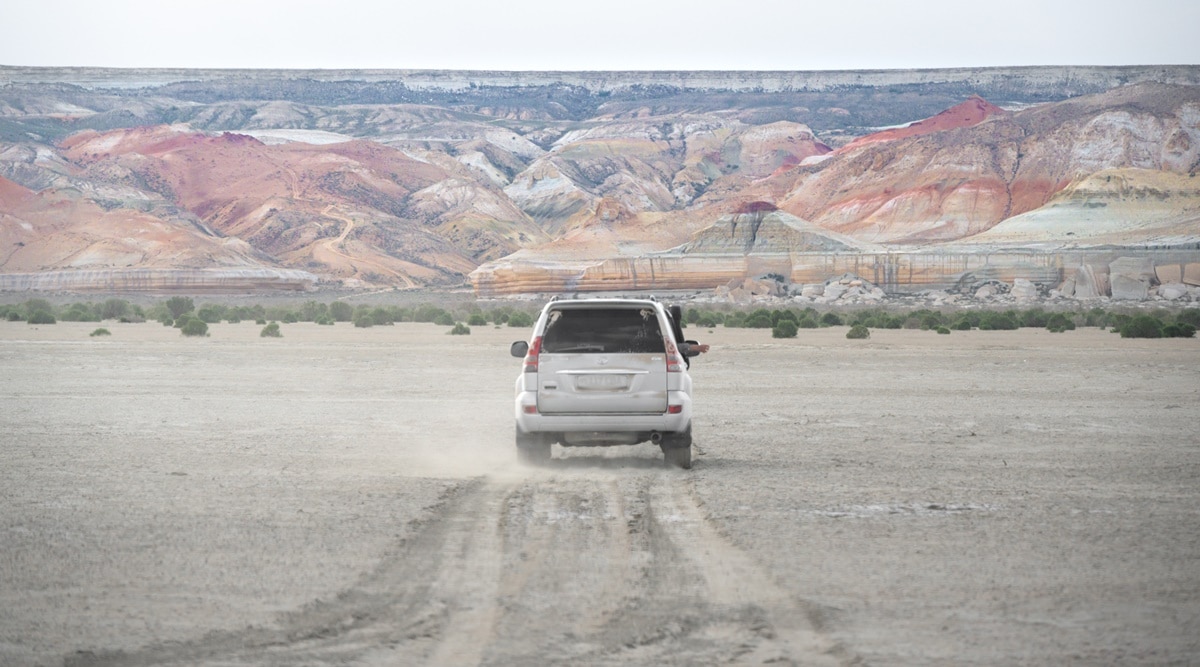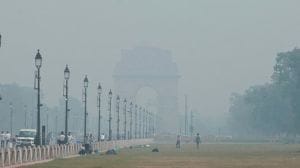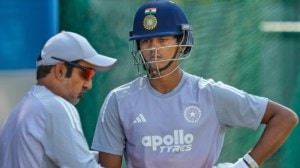Moynaq is a part of Karakalpakstan, an autonomous republic which territorially belongs to Uzbekistan, occupying the country’s northwest, with Nukus as its capital. Moynaq is about 200 km from Nukus, and is arguably one of the most stark reminders of manmade disasters in the world.

 Moynaq’s graveyard (Credit: Conor MacNeill)
Moynaq’s graveyard (Credit: Conor MacNeill)
In 1959, the port town produced millions of cans of fish every year. Now, there is just this fleet of 13 rusty ships sitting at the bottom of the erstwhile harbour of the Aral Sea, which touched Moynaq not too long ago. The sea has retreated by at least 200 km now. If one were to seek the sea now, it would take a five-hour journey from Moynaq. As the sea started retreating, the people of Moynaq too began to move out. Estimates say that in the last six decades, the population here has fallen by half.
At the shipwreck cemetery, schoolchildren are brought for field trips, while the vast, desolate landscape is also a photographers’ delight. New, rather basic backpacker hostels have mushroomed over the last few years to cater to tourists. There is also a museum dedicated to the Aral Sea, where a 15-minute video plays on loop, detailing the ecological disaster. Ironically, disaster tourism has infused hope in the remaining local population that they might not have to leave their home like many others.
***
For about a thousand years, from the 1st century onwards, Karakalpakstan was a thriving agricultural area supported by extensive irrigation from the Amu Darya, one of the biggest rivers in Central Asia. Strategically located, it was an important (and also fiercely contested) territory of the Khorezm empire, evident from the over 50 fortresses built by them during their reign in the 11th-12th centuries.
Karakalpakstan was ceded to the Russian Empire in 1873. Under Soviet rule, it was an autonomous area within the Russian Soviet Republic before becoming part of Uzbekistan in 1936. The region was probably at its most prosperous in the 1960-70. However, Karakalpakstan is now mostly desert, and the economy, which used to be heavily dependent on fisheries in the Aral Sea, is now supported by cotton, rice and melons.
In the 1960s, the Soviet government began to divert water from the Amu Darya and Syr Darya rivers that feed into the sea, and irrigate the nearby desert region for monocultural agriculture — mostly water-intensive cotton. The diversion stopped the inflow of water into the Aral Sea, causing it to dry up, while the agricultural chemical in the diverted water caused severe pollution that resulted in toxic levels of salinity in the water and consequent evaporation of the Aral Sea.
Story continues below this ad
Over the years, the environmental degradation has led to summer temperatures rising up by 10-degree Celsius and winter temperatures falling by 10 degrees. In the absence of the sea or the communities it nurtured, all that greets the eye is a vast desolate landscape.
*****
Beyond Moynaq, there is no sign of civilisation – no gas stations, shops, eateries, houses, or people! And no mobile towers. Once you cross the town, there is no network and no connection to civilisation.
When I was told about the impending ‘disconnect’ a night before the journey from Moynaq, I was reluctant. Ever since cell phones became a reality, I have never been “unavailable” to friends, family or work. Would I be able to handle it, I wondered?
 The drive on the erstwhile Aral Sea bed (Credit: Conor MacNeill)
The drive on the erstwhile Aral Sea bed (Credit: Conor MacNeill)
As soon as we crossed Moynaq in our SUVs (there is no public transport here. In fact, there are no designated roads even), the network started to fade and, with it, my heart sank. Hope arrived in the form of Arijit Singh and Shah Rukh Khan — as I asked the driver to play some music, after a slew of local Karakalpak and Uzbek songs, came Hum tere bin… from Aashiqui 2 by Singh. It felt like an instant connection.
Story continues below this ad
Singh is hugely popular in this part of the world and his songs even have Karakalpak versions sung by young local artistes. Our driver also told us how SRK is a favourite in the country, and most people have watched his Kuch Kuch Hota Hai (1998) and Kabhi Alvida Naa Kehna (2006) with Uzbek/ Kazakh subtitles. The pangs of disconnect subsided a bit.
***
The yurt camp is one of the most distinctive symbols of Central Asia, a portable tent accomodation covered with camel hide. Just like the Kyrgyz and the Kazakhs, the Karakalpaks have their own yurt building tradition. In fact, it’s the only option to stay if you are heading on an adventure to follow the Aral Sea. Since tourism has just opened up here, there are just two yurt locations on the erstwhile Aral Sea bed, the most popular being the Bes Qala Yurt Camp just beside the Aral Sea.
 Yurt camp (Credit: Conor MacNeill)
Yurt camp (Credit: Conor MacNeill)
Accommodation in a yurt is very basic, there is no attached bathroom or electricity. But it is an experience to spend a night or two away from towns and cities, enjoying the quiet of the desert and the brightness of the stars overhead. By the end of it, one learns to live without a cellphone, spot the stars at night, make friends with stray cats and dogs, and be aware of the climatic havoc facing the planet.



 Moynaq’s graveyard (Credit: Conor MacNeill)
Moynaq’s graveyard (Credit: Conor MacNeill) The drive on the erstwhile Aral Sea bed (Credit: Conor MacNeill)
The drive on the erstwhile Aral Sea bed (Credit: Conor MacNeill) Yurt camp (Credit: Conor MacNeill)
Yurt camp (Credit: Conor MacNeill)





























